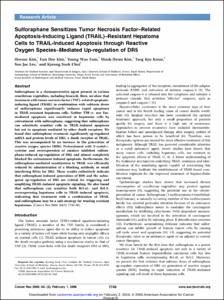Sulforaphane Sensitizes Tumor Necrosis Factor–Related Apoptosis-Inducing Ligand (TRAIL)–Resistant Hepatoma Cells to TRAIL-Induced Apoptosis through Reactive Oxygen Species–Mediated Up-regulation of DR5
- Keimyung Author(s)
- Kwon, Taeg Kyu
- Department
- Dept. of Immunology (면역학)
- Journal Title
- Cancer Research
- Issued Date
- 2006
- Volume
- 66
- Issue
- 3
- Abstract
- Sulforaphane is a chemopreventive agent present in various cruciferous vegetables, including broccoli. Here, we show that treatment with tumor necrosis factor (TNF)–related apoptosis-inducing ligand (TRAIL) in combination with subtoxic doses of sulforaphane significantly induces rapid apoptosis in TRAIL-resistant hepatoma cells. Neither TNF-α- nor Fas-mediated apoptosis was sensitized in hepatoma cells by cotreatment with sulforaphane, suggesting that sulforaphane can selectively sensitize cells to TRAIL-induced apoptosis but not to apoptosis mediated by other death receptors. We found that sulforaphane treatment significantly up-regulated mRNA and protein levels of DR5, a death receptor of TRAIL. This was accompanied by an increase in the generation of reactive oxygen species (ROS). Pretreatment with N-acetyl-l-cysteine and overexpression of catalase inhibited sulforaphane-induced up-regulation of DR5 and almost completely blocked the cotreatment-induced apoptosis. Furthermore, the sulforaphane-mediated sensitization to TRAIL was efficiently reduced by administration of a blocking antibody or small interfering RNAs for DR5. These results collectively indicate that sulforaphane-induced generation of ROS and the subsequent up-regulation of DR5 are critical for triggering and amplifying TRAIL-induced apoptotic signaling. We also found that sulforaphane can sensitize both Bcl-xL- and Bcl-2-overexpressing hepatoma cells to TRAIL-induced apoptosis, indicating that treatment with a combination of TRAIL and sulforaphane may be a safe strategy for treating resistant hepatomas.
- Keimyung Author(s)(Kor)
- 권택규
- Publisher
- School of Medicine
- Citation
- Heesue Kim et al. (2006). Sulforaphane Sensitizes Tumor Necrosis Factor–Related Apoptosis-Inducing Ligand (TRAIL)–Resistant Hepatoma Cells to TRAIL-Induced Apoptosis through Reactive Oxygen Species–Mediated Up-regulation of DR5. Cancer Research, 66(3), 1740–1750. doi: 10.1158/0008-5472.CAN-05-1568
- Type
- Article
- ISSN
- 0008-5472
- Appears in Collections:
- 1. School of Medicine (의과대학) > Dept. of Immunology (면역학)
- 파일 목록
-
-
Download
 oak-aaa-00831.pdf
기타 데이터 / 4.02 MB / Adobe PDF
oak-aaa-00831.pdf
기타 데이터 / 4.02 MB / Adobe PDF
-
Items in Repository are protected by copyright, with all rights reserved, unless otherwise indicated.